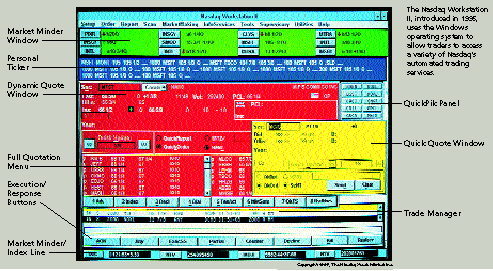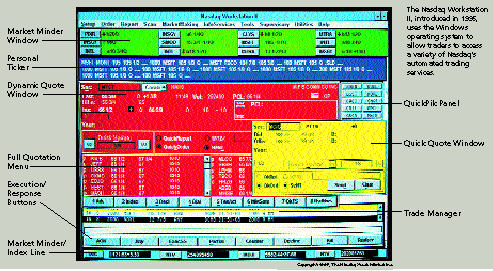Nasdaq’s Technology Floor: Its President Takes Stock
On-line trading technology evolves at the first stock market to be based on a computer network of display screens

Over the years, electronics technology has revolutionized virtually every securities market, most notably The Nasdaq Stock Market Inc. Nasdaq, a trademarked name, was the world's first market to handle trading not on an exchange floor but through a computer network linking display screens. But since its advent in 1971, changes in telecommunications and computer technologies have been ongoing, profound, and complex.
As a screen-based market, Nasdaq (which originally stood for National Association of Securities Dealers' Automated Quotations) has striven to stay on top of those developments. It is in the process of completing a US $180 million systems migration program--the largest single telecommunications and computer project undertaken by a U.S. stock market. The effort has involved replacing the entire Nasdaq system with a standards-based, client-server network, while moving from analog to digital network technology and upgrading the core systems to process 500 transactions a second--a rate that enables the market to handle at least a billion shares a day. With these systems, Nasdaq has the flexibility to constantly improve operational efficiency and regulatory oversight.
Technology breeds innovation
In light of Nasdaq's ongoing growth, that transaction capacity is critical. But in the long run, the value of technology lies not in being able to do more work more quickly, but in the opportunity to innovate. Nasdaq's history is in itself an example of how technology can drive innovation. At its most basic level, screen-based trading eliminates physical limits on who can be in the market. Investors and brokers in New York City, London, Singapore, or anywhere else can have access to the same trading information at the same time. The result is a kind of democratization of markets because no one gains an advantage by being in a certain location.
This decentralized approach makes it possible to have multiple market makers--the name for dealer firms that put their own capital behind a stock. At the traditional exchanges, where buyers and sellers meet on a trading floor, each company's stock has a single specialist making a market in that stock. On Nasdaq, however, there are virtually no limits to the number of market makers. The average Nasdaq stock has 11 market makers, and some of the largest companies' stocks--such as Microsoft or MCI--may have more than 50 vying for investors' orders.
This competing network of dealers is a central strength of a screen-based market. Open competition is the key to efficient pricing and to ensuring that investors get the best possible price and execution for their orders. In addition, academic studies have shown that Nasdaq's multiple market-maker system increases liquidity (that is, the dollar volume of trading that can occur without affecting the price of a stock). With a number of dealers committing capital to a given security--and thereby spreading any risk--the market has the capacity to absorb large increases in volume without the need for trading halts.
The open, competitive nature of Nasdaq will be enhanced by its implementation of the new order-handling rules that the U.S. Securities and Exchange Commission (SEC) has set to take effect Jan. 20. Under these rules, market makers must display investors' limit orders in their quotes when the orders are priced better than the market maker's quote. Also under the new SEC rules, market makers must display their most competitive quote publicly, not merely in a proprietary trading system. These rules make things better for investors. They give investors access to the best possible price and permit investors to have their interest in buying or selling shown to the entire world on some 300 000 Nasdaq terminals. Technology will be the key to the implementation of the new SEC rules, and Nasdaq is working with market participants to interface its systems and theirs so that this comprehensive quotation display can take place. Concurrently, Nasdaq is completing work on a proposed trading system called NAqcess that will automate the processes required by the SEC's rules.
Technology is not only an enabler of competition--it is also an effective tool for ensuring that competition remains fair. A screen-based market is really an open, electronic community. It tends to be very transparent--anyone on the network can see precisely what is taking place, as it takes place.
This transparency is enhanced by an array of computer systems that monitor the market and act as powerful complements to on-site compliance visits. For example, a system called StockWatch Automated Tracking (SWAT) uses sophisticated statistical models to continuously compare real-time market activity with historical trading patterns. If the SWAT system spots any discrepancies in prices or volumes, it flags that information for market surveillance analysts. At the same time, the system pulls up relevant stories from the Associated Press and Reuters newswires to help analysts determine if the cause is something in the news.
A new generation of technology is also at work in the market regulation performed by Nasdaq's sister subsidiary, NASD Regulation. Now in operation, for instance, is a recently completed system called Research and Data Analysis Repository (Radar). When the SWAT system detects an unusual movement in a stock, Radar rapidly pinpoints which securities firms are responsible for that trading, the precise time of each trade, how much was bought or sold, and the account involved.
Nasdaq has taken advantage of the Web technology to launch an Internet site that offers an array of current market data and index tracking (www.nasdaq.com) to investors worldwide. Quotations for all Nasdaq stocks are offered on a 15-minute delay and a glossary of financial information explains market terminology and concepts. There are also hot links to the World Wide Web sites of some 2200 Nasdaq companies.
With its new technology, Nasdaq is in a position to develop new information-based products and services. The data routinely generated by trading activity can be analyzed to yield information targeted to the market's customers. For instance, Nasdaq can give companies on-line reports that compare their stocks with others like them, or that track who is most active in their securities.
A key element of this new technology is Nasdaq Workstation II. Through it, brokerage firms may access Nasdaq quote and execution services, may merge Nasdaq data with feeds from in-house systems and outside vendors, or may rework that data with in-house software tools.
A worldwide trend
Rapid growth of screen-based trading is expected to continue. Therefore, in April 1996, the Nasdaq Board approved construction of a $33 million data center next door to its current facility in Trumbull, Conn. The center is intended to help increase Nasdaq system capacity from one billion shares a day to two billion.
Based on success of this order, we believe that Nasdaq's experience provides a model for how technology can be harnessed by securities markets. Indeed, in recent years, more and more markets around the world have moved to screen-based trading, and that trend continues. According to the Fédération des Internationale des Bourses de Valeurs, Paris, of the 45 developed stock markets in the world, only three still rely exclusively on a trading floor. The rest are either entirely screen-based (28), or employ screen-based trading to supplement floor transactions (14).
In the '80s, for instance, the London Stock Exchange converted to screen-based trading as part of the "Big Bang" securities industry reforms. Even before that event, the Exchange had designed SEAQ, an automated quotation system modeled after Nasdaq. On the Pacific Rim, the Stock Exchange of Singapore patterned an automated system, Sesdaq, after Nasdaq, and in Japan, Jasdaq was also developed using Nasdaq as a prototype.
When work began in the '90s on a pan-European stock market, Nasdaq was again adopted as a model because a decentralized, screen-based market would permit participation from any part of Europe. One initiative is Easdaq, the European Association of Securities Dealers' Automated Quotations system, which began operating in 1996. A second pan-European, screen-based market project, Euro.NM, is joining France's Nouveau Marché, already in operation, with what will be the New Market of the Brussels Stock Exchange and the Neuer Markt of the Deutsche Börse.
The move to free market economies in Central and Eastern Europe and the former Soviet Union has stimulated a great deal of capital market development there. Russia's nascent national electronic market was built with Nasdaq assistance and uses software licensed from Nasdaq. A similar initiative is under development in Ukraine. The Nasdaq model and software are also the foundation of Rasdaq, supporting Romania's privatization program.
The common element among these initiatives and others is the deployment of automated screen-based trading systems giving affordable access to market participants wherever they are located, eliminating the need for a trading floor and reducing transaction costs. Automation is used to bring all market participants together in a fair and orderly way without physically congregating in one place to shout for orders in an open outcry auction.
Note: StockWatch Automated Tracking, Research and Data Analysis Repository, and Nasdaq Workstation II are registered service marks (SM) of The Nasdaq Stock Market Inc.
About the Author
Alfred R. Berkeley III has been president of The Nasdaq Stock Market Inc., Washington, D.C., since June 1996. For five years before that, he was managing director and senior banker of the corporate finance department of Alex. Brown & Sons Inc., Baltimore, Md., where his focus was large companies in computer software and electronic commerce. From 1989 to 1991, on leave from Alex. Brown, he was on the executive committee of Safeguard Scientifics Inc. and chairman of a number of its subsidiaries. Among earlier posts at Alex. Brown, he was head of information services, supervising the upgrade of computers, systems development, telecommunications, and video technology.
To Probe Further
The Nasdaq Handbook, revised edition (printed by Probus Publishing, Chicago, 1992), contains articles by securities industry professionals, corporate executives, regulators, and academics on such topics as the structure, technology, companies, investment opportunities, and economic contributions of The Nasdaq Stock Market. The handbook may be purchased for $32.50 from NASD MediaSource, which may be contacted at 301-590-6142.
The Nasdaq Stock Market's Web site (www.nasdaq.com) supplies stock quotations and news-wire business information on a 15-minute delayed basis, as well as current stock index values and links to approximately 2000 Web sites of Nasdaq companies.
